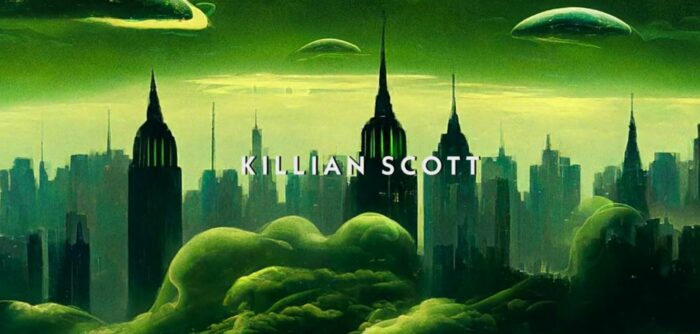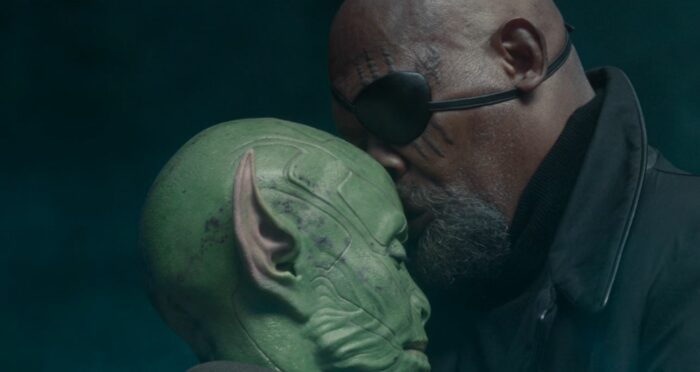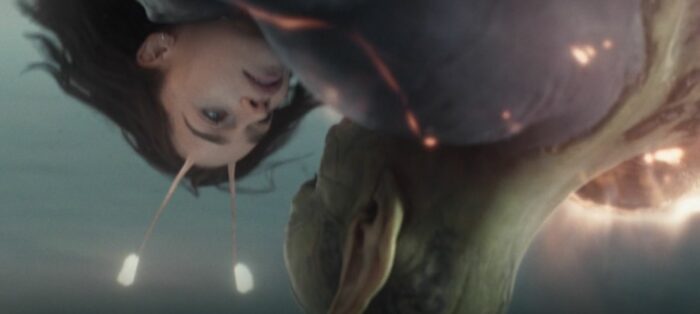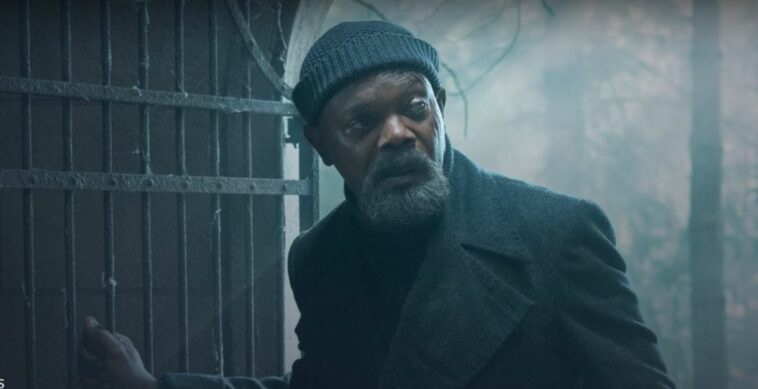The following review contains spoilers for the entire season of Secret Invasion, (created by Kyle Bradstreet and Brian Tucker).
Editor’s Note: This piece was written during the 2023 WGA and SAG-AFTRA strikes. Without the labor of the writers and actors currently on strike, the series being covered here wouldn’t exist.
When Secret Invasion was launched in early June on Disney+, it received a significant amount of backlash for one specific and unexpected thing. The opening title credits to the new Marvel Cinematic Universe show were partially generated by an artificial intelligence (AI) service that created the swirling artwork that played throughout those credits.
It was seen as especially poor timing because just one month earlier the WGA went on strike for, among other things, their unique creative rights. Studios were (and still are) playing with the idea of using artificial intelligence or script generators for products such as screenplays and other intellectual property.

Many described it as incredibly insensitive that Disney and Marvel would use that type of technology at a time when their own writers were striking due to the uncertain future of technologies in the industry such as artificial intelligence. Now, SAG-AFTRA has also gone on strike. The writers and performers want assurances that their creative work and their individual likenesses will be used with their permission and will always be fairly compensated.
The stance of the writers is fair and just, and it is widely believed that AI can not provide the tone, nuance, and emotion to a story that a human writer or performer can.
It’s disappointing, therefore, that much of the writing and plot development in this limited series also seems as though it could have been generated by some sort of artificial intelligence. In an overarching way, this series lacked the heart, character development, and motivation that was so prevalent in movies such as Iron Man, Spider-Man: Homecoming, Captain American: Winter Solider, and Avengers: Infinity War. Instead of a character-based espionage thriller, what we got played more like a mediocre cover band revisiting some of the MCU’s greatest hits and not offering any propulsion of the characters or the universe. With no less than 15 executive producers and editors listed on the project, this seems to have been caught up in MCU production hell and the result was a watered-down version of what Secret Invasion is really supposed to be.
If that assessment seems overly critical and unwarranted, it’s because I, perhaps Marvel and the Marvel Cinematic Universe’s (MCU) biggest supporter, was so completely underwhelmed and uninspired by the lack of creativity, lack of tension, and the lack of basic necessity from this series that should have had so much potential.

When the Secret Invasion comic book storyline was introduced in late 2007 and early 2008, it was a watershed event for a comic book publishing company still recovering from the depths of bankruptcy in the late 1990s after the comic book boom earlier that decade. Massive story events like Civil War (which would be depicted in an MCU movie), and Secret Invasion were world-changing moments that aligned with the 2008 introduction of the Marvel Cinematic Universe and reinvigorated the popularity of the characters and the brand that were so popular from the 1960s through the late 1980s.
The Secret Invasion comic books read as an eight-chapter mystery thriller that left readers wondering which of their favorite heroes were actually members of the Skrull race (they are shape-shifting aliens). How long have they been that way and how did the secrets explain some of their past actions? Headlining characters such as Captain America, Iron Man, Thor, Daredevil, the Fantastic Four, and many others were part of the intricate plot that would eventually culminate in a battle between Earth’s heroes (teamed up temporarily with Earth’s villains) and a massively powerful Skrull race that included a few of the Super-Skrulls we saw in the finale of Secret Invasion.
Because the entire series was high stakes, impactful for the future, and left readers guessing throughout the entire run, it was the antithesis of what this lackluster Disney+ series inevitably became. Some of the visuals and a handful of the performances such as Ben Mendelsohn’s Talos and Olivia Colman’s Sonya Falsworth are to be commended, but the plot and the ramifications of the story seem to be no better conceived than what any superhero-aware AI program could come up with if you fed it a few pieces of data about the last 15 years of the MCU.
(And to be fair, two of my favorite characters of the summer have both been played by Olivia Colman. First, Chef Terry in The Bear, and in this series as the upbeat British spy/interrogator Sonya Falsworth. But she couldn’t save the series by a long shot.)
What caused it to fall so flat for me, for many other critics, and for the many Marvel faithful who have given the show a 57% rating on Rotten Tomatoes (the lowest among all Disney+ MCU programs)? This was just one uninspired domino falling right after another.
Viewers who were paying attention when the first pieces of footage and the first trailer for this show were released over a year ago immediately caught on to the fact that there were no other known MCU superheroes in this show beyond Nick Fury (played by Samuel L. Jackson) and Colonel James Rhodes (played by Don Cheadle and also known as War Machine). Seeing how Nick Fury was the named protagonist for the show, no one was surprised when Colonel Rhodes was revealed to be a Skrull in Episode 4.

(And on a side note, how does a Colonel have that much exclusive access to President Riston, played by Dermot Mulroney? Even if Rhodes was once someone who helped save the world, it wasn’t clear what his executive branch role was.)
What was surprising to learn in the finale (“Home”) was just how long Col. Rhodes had been subsumed by another alien body. It turns out that while Rhodes was recovering from being shot out of the air in the final battle in Captain America: Civil War, that was the time when the Skrulls infiltrated his body. What this means is that some of the most emotional arcs we saw out of that character were nothing more than an act put on by an alien inhabiting his body. When Rhodes is at Iron Man’s side for his death in Avengers: Endgame, the emotion we see from Col. Rhodes was fake. When we see Rhodes at Tony Stark’s funeral, those moments were also fake. When we saw Rhodes trying to track down Clint Barton (Hawkeye) after Barton’s mental break when he lost his family in The Blip, the desperation and helplessness we see from Rhodes in his search? Also fake.
And even if we can look past what is now considered James Rhodes canon in the MCU thanks to this six-episode run, the trajectory and, frankly, the point of this entire series was completely missing.
When the show begins, Nick Fury is off-world at S.A.B.E.R. trying to build an intergalactic shield to protect Earth. When the show ends he is traveling up to S.A.B.E.R. to continue doing the very same thing. Why did he have to come to Earth again? Right, because the Skrulls were mad that Nick Fury wasn’t off looking for the new planet for their race he promised them more than 30 years ago. A fraction of the young, rebellious Skrulls were mad that he was instead saving Earth multiple times over; the same Earth which just so happens to include the 1 million Skrulls now living on this planet.
“Sorry we defeated Loki, defeated Ultron, and brought back the half of your population that Thanos eliminated! Sure, go ahead and get mad at us for not checking the galactic Zillow!”

Accompanying Fury to S.A.B.E.R at the end of the series is his wife Priscilla (or Varra, as she is known in her Skrull dialect, played by Charlayne Woodard). Apparently, Nick Fury has been in a relationship with a Skrull for an extended period of time. Were we aware of this? We were not. Were we aware of any relationship he had outside of his merry band of world-savers? Nope. Did this relationship matter to the plot of this show? It did not.
It only served as a weak, emotional point of tension that would force Nick Fury to briefly question his intentions with the Skrulls. He never hesitates on whether he plans to leave her again to go back to S.A.B.E.R. He leaves her to go fight her race no fewer than four times in the series. Only this last time Fury convinces her to come with him because he’s “no good with people?” Because she is the “best diplomat the Skrulls have ever had?” Since when? How do we know?
Her inclusion not only in this show but also in this broader universe lacks comprehension for me. Will we ever see her again? Perhaps, but with the Skrull rebellion behind us, she only has some nominal role in a surprise peace summit between the Skrulls and the Kree race.
But all these pale in comparison to the incomprehensibility of the real whole reason why Nick Fury came back to Earth in the first place. His good friend Talos (played by Ben Mendelsohn) needs Fury’s help to squash a zealous rebellion by a newly-appointed Skrull general, Gravik (Kingsley Ben-Adir). Mendelson, who is far and away one of the better performers on this show, doesn’t even make it four episodes before he is killed in action by Gravik and his men. This does inspire his on-the-fence-about-everything daughter G’iah (Emilia Clarke) to follow in her dad’s righteous footsteps, so there is some motivating arc. But why give such a talented performer and ally of our protagonist so little to do in this series?

Gravik’s plan is to deceive countries like the United States and Russia into thinking they are acting aggressively and violently toward the other, hoping that humans will turn against humans and begin to destroy themselves, leaving the planet available for the Skrulls’ taking. Well, I got news for you buddy. We don’t need the Skrulls’ help to make all that stuff happen. We are doing just fine turning on one another and destroying our planet without any alien interference, thank you very much.
While the world is in chaos, Gravik planned to steal a MacGuffin referred to as The Harvest. Have you heard of The Harvest before this series? Certainly not. But apparently, in the more than seven years since The Blip, someone has been collecting and storing superhero DNA, creating a sort of super-serum that would make even Steve Rogers, Peggy Carter, and Doctor Abraham Erskine jealous. Gravik intends to insert this superhero DNA cocktail into some of his followers and himself, creating the Super-Skrulls that can shape-shift into the form (and with the powers) of the superhero whose blood now runs in their veins.
Somehow their powers, even though many of the stated heroes in this DNA blender have no powers as part of their DNA, will be seamlessly integrated into the Skrulls’ DNA. Captain America, Mantis, Winter Soldier, and others we see manifested in the final showdown between G’iah and Gravik are powerful for reasons outside of what’s in their DNA. I’m no molecular biologist, but it just doesn’t make one bit of sense. Yes, Skrulls can change their appearance. That doesn’t give them Thor’s strength as a result.

And if Gravik is such a brilliant tactician and the elected leader of 1 million members of a superior alien race, how was he so easily fooled that G’iah could shape-shift into Nick Fury, allowing her access to The Harvest and the Super-Skrull abilities in order to face her father’s killer? It just reads as lazy plot construction that drives its way into an even lazier and more predictable trademark MCU CGI slugfest where the special effects experts get to just pull all the past hero weapons out of their tool belts and slap them on these two characters in the final showdown.
I think the final battle where both G’iah and Gravik spend 10 minutes just wielding every power they can ever hope for serves as quite the metaphor for the MCU at large as we approach the 33rd movie this fall and two more Disney+ shows airing before the end of 2023.
Since Iron Man introduced the MCU in 2008, the Universe, much like our heroes, who discover grow with, and eventually conquer, their new abilities, has been building and growing and prospering to a point where we expect a certain level of maturity and responsibility with this intellectual property. But when you can just shove a vial of mixed-up DNA down a random alien’s throat and all of a sudden they are more powerful than any character we’ve seen in the last 15 years, what is it even the point of building this universe in the first place?
If that level of ability creation is available, who needs origin stories and conflict and character development? Let’s just collect a drop of blood from every registered hero, give everyone a super-shot and we’ll be assured no one will be able to challenge the inhabitants of Earth ever again. We knew we were about to see Captain Marvel again in The Marvels coming out in November. But why does she matter now? Many believe she was the most powerful being in the universe, but now G’iah is her equal (if not her superior) and anyone with access to a few drops of DNA can have her powers and more.
Characters like Captain Marvel have been minimized by this DNA proliferation. The superhero scarcity once created the demand, and now, in the words of Syndrome, “If everyone is Super, then no one is.”
Unless G’iah is about to become an integral part of the Marvel Cinematic Universe (which at this point could or could not happen), I still fail to see what destination this show was driving towards. Were Cobie Smulders (RIP Agent Maria Hill) and Ben Mendelsohn looking for an MCU exit and this was the best way to do it? Was Don Cheadle unhappy with his backstory?
Much of this story for the show was pitched as what type of sacrifice Nick Fury would have to make to save the world. But even before this show aired we saw in previews for The Marvels that Fury was alive and well back up in S.A.B.E.R. That immediately lowered the stakes of the show to zero knowing that Fury was still alive, there still is an Earth, and the Marvels are clearly not going to be battling the Skrulls or the Kree.
I’m disappointed in so many things about this show, and certainly the superhero fatigue is creeping up on me. But I think I’m most disappointed by the fact that they took wonderful source material and turned it into something that didn’t need to exist in the first place.
Being such a fan of the source material and the MCU to this point I am willing to give maybe the largest benefit of the doubt that can be afforded to projects like this. But if Kevin Feige and the decision-makers at Disney and Marvel are going to choose to continue to produce lazy, tired, and meaningless material for this universe, I don’t see how we as fans can do anything other than follow Nick Fury’s lead and leave this world for a long, long time.

